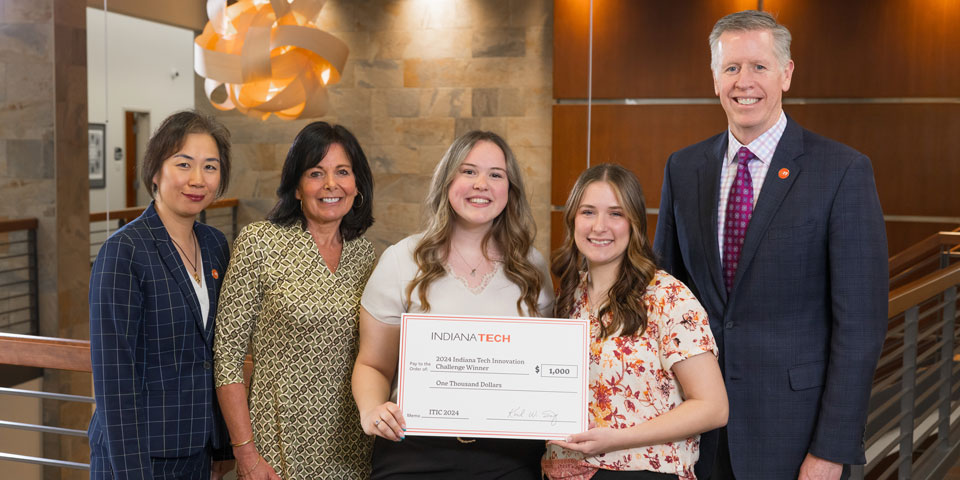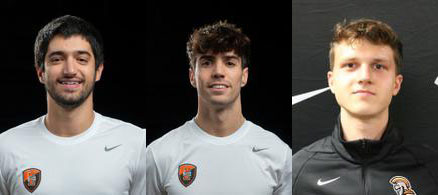Indiana Tech’s Innovation Challenge has been giving students a platform to showcase their great business ideas against fellow student entrepreneurs since 2021.
This spring’s competition was stocked with teams that shared a focus on making life better for mankind. Four teams were rewarded for their innovative ideas with funding that will help them move their ideas forward—hopefully into viable business opportunities.
“The Innovation Challenge never fails to amaze in the way it inspires forward-thinking approaches to problem-solving and teamwork among students of various disciplines,” said Dr. Naga Musunuri, assistant professor of mechanical engineering. “This year’s submissions have significant social, economic and environmental impacts, which is quite impressive.”
Teams submitted applications to participate in the Innovation Challenge, which included a project summary. From there, teams selected to move forward got an opportunity to pitch their ideas in front of a panel of judges, which included Dr. Musunuri, Dr. Zak Al-Hamouz, associate professor of electrical engineering, Dr. Mauricio Torres, associate professor of mechanical engineering, and Dr. Staci Lugar Brettin, professor of marketing and management. Below are summaries of the top four projects.
First Place

Water Filtration System for Underserved Communities
Team Members: Kylie Baron, Chayton Bass, Madison Maes (all mechanical engineering majors; Baron and Bass graduated in May, Maes will graduate in 2025)
Prize: $1,000
Project Summary: Baron, Bass and Maes developed a design concept for Clean Flow Innovations, a portable, lightweight water-filtration system that is solar-powered. The system is designed with a large funnel to collect rainwater, which will pass through a filter and a sanitizing ultraviolet light before ending up in a final collection tank. The team anticipates this product will be a portable and affordable solution that will help provide safe drinking water for people who have none. According to the group’s research, 2.2 billion people worldwide do not have safe drinking water while 76% of the world’s countries have limited access to safe drinking water.
“Our main goal is to help others—we focus a lot on the greater good, Baron said of what motivated her team to come up with this product. “Knowing that people go through situations like we have researched, it was very important to us to create a product to help mitigate those issues.”
Clean Flow Innovations’ customer base would include governments of countries affected by clean water shortages, missionaries and other humanitarian initiatives such as the Peace Corps and Doctors Without Borders.
Moving Forward: The team will be completing its prototype to do real-life testing in the fall. It is also seeking organizations with which it can partner to do more in-depth and proper testing. From there, the group will use its findings to fine-tune its product. If all goes as planned, Clean Flow Innovations will be ready for customers by the end of 2025.
“Thankfully, due to our similar outlooks on life and helping others, every moment of this project has gone smoothly so far,” Baron said. “My most impactful takeaway is when you have an idea that you are passionate about, don’t hesitate to make it a reality. Just a single thought or idea can impact so many people.”
Second Place

Prototype to Convert Tidal Energy into Electricity
Team Members: Tobias Machourek, David Perez, Andreas Lavdas (all mechanical engineering majors, who graduated in May)
Prize: $500
Project Summary: Influenced by data that estimates 760 million people lived without electricity in 2022, Tobias, David and Andreas began working on a tidal energy prototype to generate renewable energy. Their prototype will harness the power of the ocean and utilize a coil and magnet system to convert kinetic energy into electricity.
“This project was important to us because it combines our passion for renewable energy with the opportunity to innovate in wave energy conversion, offering a practical solution to harness untapped natural resources and contribute to sustainable development,” Machourek said about his team’s motivation.
Moving Forward: This team continue to test and refine its prototype to optimize its performance. To be successful, the prototype must:
- Withstand harsh marine environments
- Seamlessly integrate with existing energy infrastructure
- Be scalable for applications where more significant energy generation is needed.
- Be fully compliant with environmental regulations and standards to ensure minimal impact on marine ecosystems and habitats
At the same time, the team will seek partnerships for further development and explore options for commercialization to bring the renewable energy solution to a wider market.
“Working on this project with my team was great; it showed us how combining different ideas and skills can help us tackle challenges and succeed together,” Machourek said.
Third Places (tie)
The Fine Art of Oxidation
Team Members: Jessica Hartmus (mechanical engineering major, who graduated in May) and Laura Hartmus (PFW student)
Prize: $250
Project Summary: Jessica and her sister, a secondary education major, identified that students who struggle with math and science coursework between grades 4 and 8 are more likely to be less engaged with STEM learning opportunities overall. However, they also found that implementing the arts in STEM learning increases student engagement. To bridge the gap, the Hartmuses want to create kits that will allow users to produce colorful artwork on a piece of 4” by 6” titanium through the scientific process of anodizing. Included in the kits are an electrified (by battery) paintbrush and a colorless solution that, when applied to the titanium, creates an oxide layer that enhances the metal’s natural color spectrum. The kits would be available for sale to parents and individuals, STEAM camps, schools and artists.
“It is so fascinating to me that I can take a gray sheet of titanium and a colorless and mostly water solution, and paint beautiful colors through this scientific process. I don’t want to keep this to myself. I want this scientific and artistic process to be shared, accessible and engaging for others too,” Jessica Hartmus said.
Moving Forward: The Hartmuses are working with Dr. Lugar Brettin to copywright their instructional booklets. In addition, they are demonstrating their product with high school students to obtain useful feedback.
“This experience has opened my mind to possibilities that extend far beyond graduation. It is also incredibly impactful to understand how the problem-solving learned in engineering can be applied to finding better ways to engage people in STEM,” Jessica Hartmus said.
Nova Arm Innovation
Team Members: Alejandro Munoz (biomedical engineering major, who graduated in May) and Cole Collins (business administration major, who will graduate in 2025)
Prize: $250
Project Summary: Munoz and Collins’ collaborated to present Munoz’s design of an affordable prosthetic arm for anyone older than age 9 who has had a trans-radial amputation. “This project is important to me because I want to make an impact in the medical society and provide affordable health care and treatment for people who have been deprived in the United States,” Munoz said.
Munoz’s proposed design will be 3D-printed with Nylon 12, a highly adaptable material that is very popular for prosthetics and orthotics because of its ruggedness and durability. It will also be outfitted with individual muscle sensors, which will monitor incoming movements from remaining muscle groups and translate that data to the appropriate motion in the prosthetic.
Moving Forward: Munoz will work over the summer on developing his prototype and then identify next steps for Nova Arm from there. Both he and Cole said that learning to work in a team setting was the most impactful part of this experience.
“It was stressful at times—Alejandro is an engineer, and I am a business major. We do not operate the same, so it was difficult to come to a common understanding when it came to presenting the desired information. We were coming from two different ends of presentation styles. In the end, we ended up agreeing and presenting a little of both styles,” Collins said.
Collins also embraced the real-life opportunity to present and pitch an idea to an audience and act as a consultant.
Students: Bring Your Business Ideas to Life
If you are a student and would like to learn more about Indiana Tech’s Innovation Challenge, visit academics.indianatech.edu/beyond/innovation-challenge.